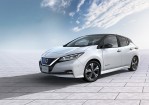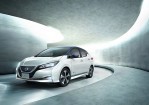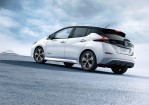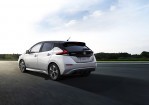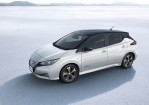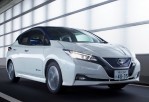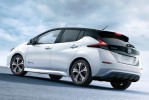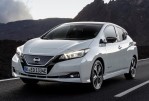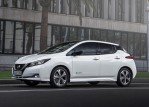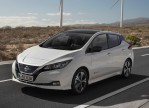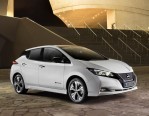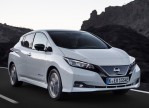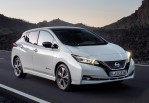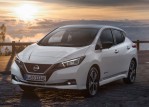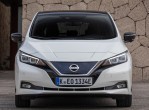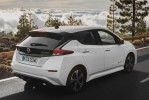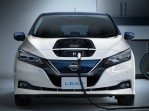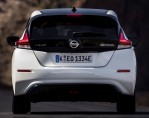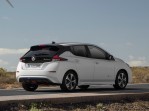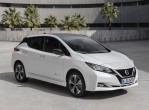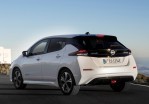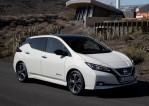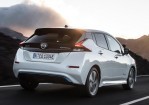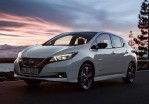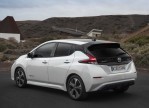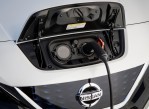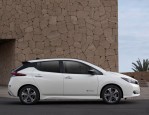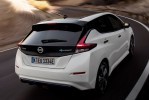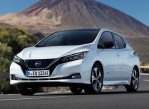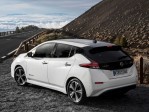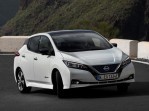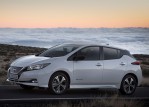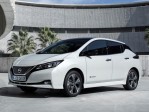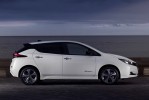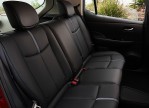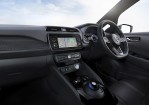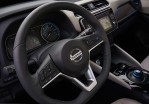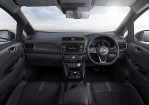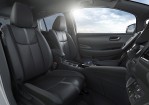Body style: Hatchback
Segment: Compact
Infotainment: ![]() Apple CarPlay
Apple CarPlay ![]() Android Auto
Android Auto
Production years: 2017, 2018, 2019, 2020, 2021, 2022
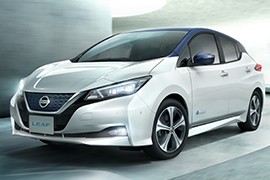 100 Photos
100 PhotosNissan introduced the second generation of the Leaf in late 2017 as a 2018 model year, and it was a much better vehicle than its predecessor, but sharing the same hatchback architecture as before.
The Japanese automaker gambled a lot in 2010 when it launched the Leaf as a full-electric vehicle during the world financial crisis when customers tried to keep their cars and not buy new ones, let alone EVs. Nissan’s gamble was rewarded since it created brand awareness for the Japanese automaker in this new segment of electric vehicles. Still, customers who were used to filling their cars at a gas station in five minutes needed something better.
Furthermore, the Leaf’s price was quite high for a compact-sized hatchback. So, when the automaker introduced the second generation of this nameplate, it improved it in all areas and created a much better vehicle.
With the second generation of the Leaf, the car showed a more mature look with a design that sported a front fascia featuring the V-shaped grille seen on other Nissan models. Its LED headlights flanked it, and the apron that sported the fog lamps looked more conventional and appealing.
From its profile, the hatchback styling with the floating roof design resembled the one from the Micra. To emphasize the ecological vehicle, Nissan placed “Zero Emission” badges on the front doors. On the rear quarter panels, the automaker installed the LED taillights that flanked the tailgate and were extended upwards on the C-pillars.
The first generation of the Leaf was criticized for not providing enough interior space for four adults. Nissan fixed that and increased the car’s wheelbase, making the cabin taller. As a result, the front passengers sat on high-mounted seats with mild bolstered areas. The driver fronted a fully digital instrument cluster and a flat-bottom steering wheel.
On the center stack, Nissan installed the touchscreen for the infotainment system that supported Apple CarPlay and Android Auto, while the center console placed between the front occupants housed the controls for driving modes and a pair of cup holders. The rear seats were mounted even higher than those from upfront since the batteries were mounted underneath them.
There was enough room for two adults in the back, but due to the tall center tunnel that crossed the cabin from front to back, a third middle-seated passenger had trouble finding a good position due to the lack of legroom. Behind the split-folding bench, the automaker created the luggage area, which was good enough for school runs and weekly shopping.
The second generation of the Leaf promised 235 miles (378 km) of range due to its new and improved 40kWh battery pack. Among other essential upgrades, the second generation of the Leaf came with a one-pedal driving system and the ProPilot system that could autonomously keep the car centered on a lane and follow the vehicle in front of it until it completely stopped.
NISSAN Leaf 2017, 2018, 2019, 2020, 2021, 2022
- 40 Kw (150 HP)
- e+ 62 Kw (218 HP)
NISSAN Leaf
40 Kw (150 HP)
ENGINE SPECS - 40 Kw (150 HP) | |
|---|---|
| Power: | 110.3 KW @ 3283-9795 RPM 150 HP @ 3283-9795 RPM 148 BHP @ 3283-9795 RPM |
| Torque: | 236 lb-ft @ 3283 RPM 320 Nm @ 3283 RPM |
| Fuel: | Electric |
PERFORMANCE SPECS | |
|---|---|
| Top Speed: | 89 mph (143 km/h) |
| Acceleration 0-62 Mph (0-100 kph): | 7.9 s |
TRANSMISSION SPECS | |
|---|---|
| Drive Type: | Front Wheel Drive |
| Gearbox: | Single speed |
BRAKES SPECS | |
|---|---|
| Front: | Ventilated Discs |
| Rear: | Discs |
TIRES SPECS | |
|---|---|
| Tire Size: | P205/55R16 |
DIMENSIONS | |
|---|---|
| Length: | 176.4 in (4481 mm) |
| Width: | 70.5 in (1791 mm) |
| Height: | 61.4 in (1560 mm) |
| Front/rear Track: | 60.6/61.2 in (1,539/1,554 mm) |
| Wheelbase: | 106.3 in (2700 mm) |
| Ground Clearance: | 5.9 in (150 mm) |
| Cargo Volume: | 23.6 cuFT (668 L) |
| Aerodynamics (Cd): | 0.28 |
WEIGHT SPECS | |
|---|---|
| Unladen Weight: | 3433 lbs (1557 kg) |
| Gross Weight Limit: | 4398 lbs (1995 kg) |
POWER SYSTEM SPECS | |
|---|---|
| Power pack: | Lithium-ion |
| Maximum Capacity: | 40 kWh |
| Charger type: | 6.6 kW onboard charger |
| Range: | 151 miles (243.0 km) |
| Notes |
|---|
| 10A EVSE cable on domestic socket 0-100%: 21 hours 8A EVSE cable on domestic socket 0-100%: 26 hours 6.6kW OBC on 32A Wallbox 0-100%: 7 hours 30 minutes 50kW Quick Charger-Empty warning to 80%: 40 to 60 minutes (Time dependent on charging conditions, including Quick Charger type and condition, battery temperature as well as ambient temperature at point of use.) |
NISSAN Leaf
e+ 62 Kw (218 HP)
ENGINE SPECS - e+ 62 Kw (218 HP) | |
|---|---|
| Power: | 160.3 KW @ 4600-5800 RPM 218 HP @ 4600-5800 RPM 215 BHP @ 4600-5800 RPM |
| Torque: | 251 lb-ft @ 500-4000 RPM 340 Nm @ 500-4000 RPM |
| Fuel: | Electric |
PERFORMANCE SPECS | |
|---|---|
| Top Speed: | 98 mph (158 km/h) |
| Acceleration 0-62 Mph (0-100 kph): | 6.9 s |
TRANSMISSION SPECS | |
|---|---|
| Drive Type: | Front Wheel Drive |
| Gearbox: | Single speed |
BRAKES SPECS | |
|---|---|
| Front: | Ventilated Discs |
| Rear: | Discs |
TIRES SPECS | |
|---|---|
| Tire Size: | P205/55R16 |
DIMENSIONS | |
|---|---|
| Length: | 176.4 in (4481 mm) |
| Width: | 70.5 in (1791 mm) |
| Height: | 61.4 in (1560 mm) |
| Front/rear Track: | 60.6/61.2 in (1,539/1,554 mm) |
| Wheelbase: | 106.3 in (2700 mm) |
| Ground Clearance: | 5.3 in (135 mm) |
| Cargo Volume: | 15.4 cuFT (436 L) |
| Aerodynamics (Cd): | 0.28 |
WEIGHT SPECS | |
|---|---|
| Unladen Weight: | 3682 lbs (1670 kg) |
| Gross Weight Limit: | 4288 lbs (1945 kg) |
POWER SYSTEM SPECS | |
|---|---|
| Power pack: | Lithium-ion |
| Maximum Capacity: | 62 kWh |
| Range: | 239 miles (384.6 km) |








